Heat Conduction in One Dimension
Heat Conduction in One Dimension: Overview
This topic covers concepts, such as, Thermal Conduction, The Steady State Heat Flow, Heat Flow through Cylindrical Bodies & Heat Flow through Spherical Bodies etc.
Important Questions on Heat Conduction in One Dimension
Two metallic blocks and of same area of cross-section are connected to each other (as shown in figure). If the thermal conductivity of is then the thermal conductivity of will be : [Assume steady state heat conduction]

Six identical rods are joined together to form a network as shown. A temperature difference of can be maintained between two points. Considering heat flow through conduction only, in steady state :-
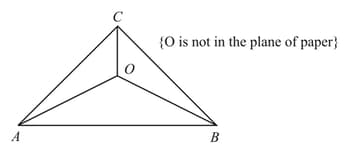
A composite cylinder is made by two materials having thermal conductivities and as shown. Temperature of the two flat faces of cylinder are maintained at and
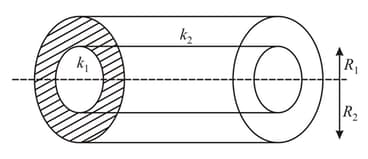
A long cylindrical flask with inner and outer diameters and respectively is completely filled with ice at as shown in the figure. The constant temperature outside the flask is (Thermal conductivity of the flask is Latent heat of friction of ice
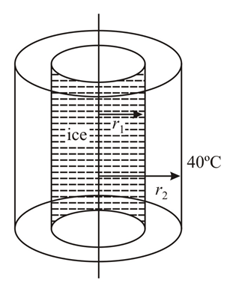
A highly thin conducting spherical shell of radius is completely filled with water at . Outside surrounding temperature is . Latent heat of fusion of water is and thermal conductivity of ice is . Assume heat is flowing symmetrically in radial direction. Choose the CORRECT option(s). Density of water is . Neglect the expansion of water on freezing.
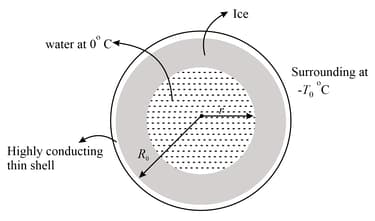
of heat is conducted through wall of thickness in . Temperature difference between the two sides of the wall is . The thermal conductivity of the material of the wall is (in ) . Write the value of .
A metal rod of length has cross sectional areas and as shown in the figure. The ends are maintained at temperatures and . The temperature at middle point is___.
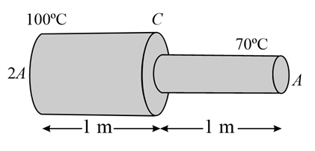
The end of a rod of length is maintained at and the end at . What is the temperature (in ) at a distance of from the end ?
A spherical shell of inner and outer radii and has variable thermal conductivity , where is coefficient of thermal conductivity and is the distance from the centre of spherical shell and is a positive constant. If inner and outer walls are maintained at different constant temperatures and respectively, then
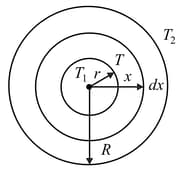
A room has a concrete roof . At some instant, the temperature outside is and that inside is . If the bricks of thickness are laid down on the roof. Calculate the rate of heat flow under the same temperature condition (neglect convection).
A -tube, made of heat- insulating material, is shown in figure. One limb is closed by a non- conducting cork, the temperature is . How much heat (in multiples of Joule) is required to be given by the coil so that the air rises to a temperature ? The thermal expansion of mercury is negligible. (Take:
Area of the tube as of SI units). Neglect the heat flow through the mercury.
A composite spherical shell is made up of two materials having thermal conductivities and respectively as shown in the figure. The temperature at the inner most surface is maintained at whereas the temperature at the outer most surface is maintained at and are four points in the outer material such that . The net rate of heat flow from the outermost surface to the innermost surface of the shell will be (Neglect any radiation)
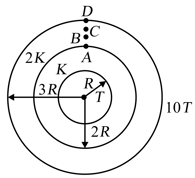
The temperature drops through a two-layer furnace wall by . Each layer is of equal area of cross-section. Which of the following actions will result in lowering the temperature of the interface?
A metal cylinder of mass is heated electrically by a heater in a room at . The cylinder temperature rises uniformly to in and finally becomes constant at . Assuming Newton's Law of cooling is valid.
Inner surface of a cylindrical shell of length and of material of thermal conductivity is kept at constant temperature and the outer surface of the cylinder is kept at constant temperature such that as shown in figure. Heat flows from inner surface to outer surface to outer surface radially outward. Inner and outer radii of the shell are and respectively. Due to lack of space this cylinder has to be replaced by a smaller cylinder of length inner and outer radii and respectively and thermal conductivity of material . If rate of radially outward heat flow remains same for same temperature of inner and outer surface i.e. and , then find the value of .
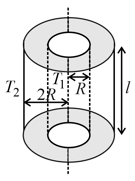
Three rods and of same length and cross-sectional area are arranged as shown. The end is immersed in ice whose mass is and is at . The end is maintained at . Heat is supplied at constant rate of . Thermal conductivities of and are and , respectively. Time after which whole ice will melt is

One end of the copper rod of uniform cross-section and length is kept in contact with ice and other end with water at . At the distance '' (in meter) from water along its length a temperature of is maintained so that in steady-state, the mass of ice melting is equal to that of the steam produced in the same time interval. Write the value of .
(Assume that the whole system is insulated from its surroundings. Latent heat of fusion of ice and vaporization of water are and , respectively.
If the transmission of heat takes through molecular collisions, it is called
In steady state heat conduction, the equations that determine the heat current [heat flowing per unit time per unit area] and temperature in space are exactly the same as those governing the electric field and electrostatic potential with the equivalence given in the table below.
| Heat flow | Electrostatics |
A copper rod of length and an iron rod of length having the same areas of cross section are connected in series. Thermal conductivities of copper and iron are respectively and units. The equivalent conductivity of the composite bar in unit is ____.
